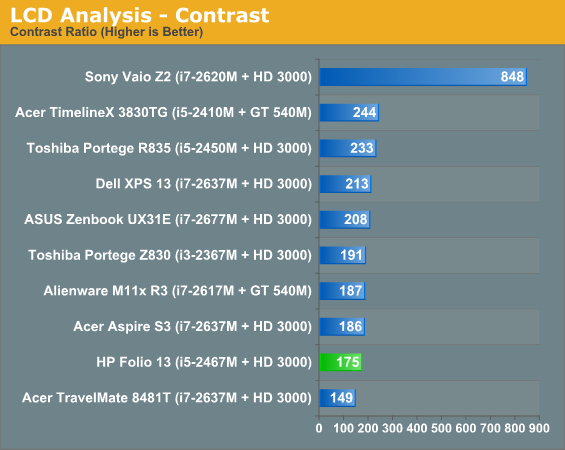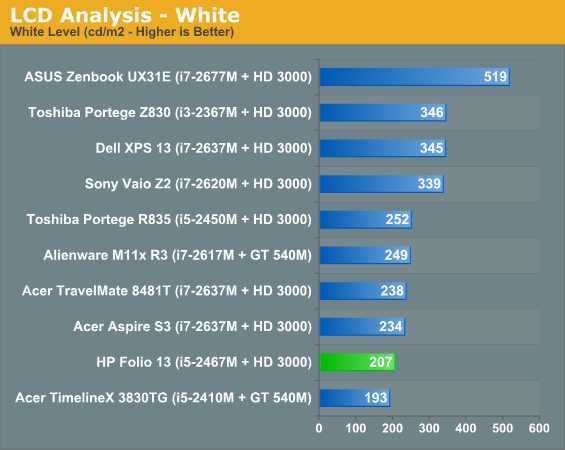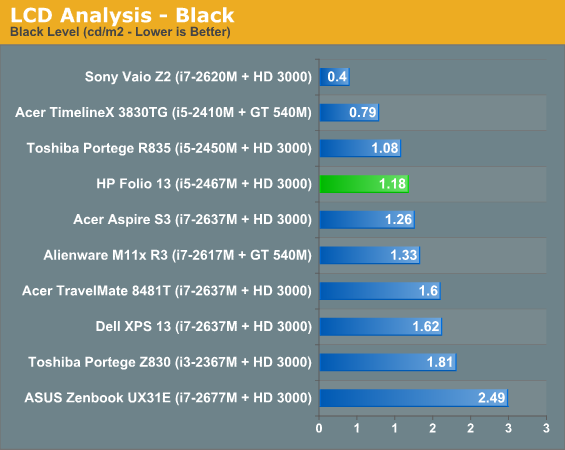HP Folio 13 Review: Deviating From the Norm
by Dustin Sklavos on April 17, 2012 12:30 AM EST- Posted in
- Laptops
- Intel
- HP
- Sandy Bridge
- Ultrabook
In and Around the HP Folio 13
After reviewing nothing but wedge-shaped ultrabooks, the HP Folio 13 is actually a bit of a breath of fresh air. HP's design here doesn't actually deviate all that much from the rest of their notebook lineup; aesthetically it sits right between their consumer and enterprise lines (much as it's intended to), and as I mentioned before they eschewed the wedge shape and kept the build right at the 18mm cusp of Intel's ultrabook spec.
The top lid and interior surface of the Folio 13 are aluminum, while the screen bezel and bottom of the notebook appear to be either carbon fiber or a rubberized treatment on matte plastic; either way, it's soft, light, durable, and attractive. In fact the only gloss on the Folio 13 is surrounding the keyboard and on the screen's interior bezel (which houses the webcam.)
.jpg)
Where HP can claim a major victory with the Folio 13 is the keyboard proper. Ultrabook keyboards, by virtue of the form factor, tend to be very shallow and can be difficult to use. Since HP's engineers seem to have gone in reverse and tried to see how big they could get the Folio while keeping it thin, light, and within spec, the result is a keyboard that has much better depth and travel. It's still not perfect and feels a little on the mushy side, but compared to the others I've tested it's much more comfortable. And as a special bonus: it's backlit.
Unfortunately, despite having an excellent keyboard for an ultrabook, the Folio 13's touchpad is another poorly implemented clickpad. As we've mentioned before and as Anand has even said to me personally, PC vendors still can't seem to get this part of the design down. Honestly I'm at a loss as to why they keep trying, as I have yet to use one that provides a tangible benefit over just using a traditional touchpad and pair of mouse buttons. At this point the only vendor with dedicated mouse buttons on their ultrabook is Toshiba. During testing I found the clickpad had such a hard time detecting misclicks that I was largely forced to use an external mouse.
Finally, the screen on the Folio 13 is another poor-quality 768p TN panel. It's not really worth going through the full rigamarole for something that bothers all of us; suffice to say it's "competitive" with the majority of what's out there in this class, though hopefully the days of dismal notebook screens are drawing to a close as tablet screens push things forward.



The remainder of the results are available in Bench, but you can tell the Folio 13's screen isn't very good even by ultrabook standards. The best in an otherwise bad bunch are the ASUS Zenbook UX31E, which at least sports at 1600x900 resolution, and the vastly more expensive Sony Vaio Z2, which runs at full 1080p but costs nearly twice what some of the other ultraportables do.


_thumb.jpg)
_thumb.jpg)
_thumb.jpg)
_thumb.jpg)
_thumb.jpg)
_thumb.jpg)








88 Comments
View All Comments
vignyan - Tuesday, April 17, 2012 - link
I am sorry - but I think the industry should not provide 768 displays for screens larger than 7" anymore. =)Oderdigg - Tuesday, April 17, 2012 - link
Very accurate review other than some spelling errors :). I bought 2 for work to test them out and I was happy with what you got considering they were $1000. My only gripe was the glossy 768p panel and the track pad. The track pad isn't a huge issue as we use good mice. I mean, who doesn't?Seems to be a lot of haters in this thread. Are people expecting a $600 laptop that's as good as a MBA? Let's be realistic. This isn't for gaming, CAD or a desktop replacement. This for people who need a quick laptop without spending too much money (MBA) and still deliver enough performance to showcase websites, cloud technology etc.
I have an HP 8460w and that thing moves. Then again, it's about 2.5X more expensive.
fruityloon - Tuesday, April 17, 2012 - link
Can the spec for the screen resolution be written as 1366x768 instead of 16:9 768p ? It makes glancing thru a tad easier.robinthakur - Wednesday, April 18, 2012 - link
If Apple can ship a tablet with a 2048x1536 resolution with an insanely thin profile for $499, why would I accept anything less in a full laptop costing way more? You mightsay that the average consumer wouldn't know the difference, but if they simply do a side by side comparison with a product which has been in the retail channel as of the end of February the difference speaks for itself. No sale HP, the MBA is vastly superior in nearly every department and holds its value in the second hand market way better.JarredWalton - Wednesday, April 18, 2012 - link
Keep in mind that one of the differences with iPad and Ultrabooks is that Apple is in full control of the OS, hardware, and software on iPad. They released the original as a 1024x768 device, and quadrupling that resolution with the new iPad is a simple matter. Any apps that don't know how to support other resolutions just see the display as a 1024x768 device and the graphics drivers handle the scaling -- which, incidentally, can make lower resolution apps and images look like crap.The GUI on iOS for iPad also runs at a set aspect ratio and they basically have two PPI settings that they need to target -- the original 132 PPI, and the new 264 PPI. If you look at the home screen on an iPad 2 vs. iPad "3", the only real difference is the iPad 3 looks a lot sharper. Now move over to Windows (or OS X), and suddenly you have DPI settings that don't actually scale across all applications -- there are many, many situations in which an app will look anywhere from slightly off to downright horrible if you use something other than the Windows default 96 DPI.
Another major issue: if you're using the 96 DPI setting on a 13" 1080p display, all the text and images become smaller, to the point where people in their 40s and later could become very frustrated by eye strain. (I had a client at one point where I helped them get set up with new PCs and 24" 1920x1200 LCDs; the receptionists and secretaries threw a fit and I finally ended up running all the displays at 1280x800 -- they were all happy, even though everything was slightly blurry and they had to do a lot more scrolling!)
In other words, I fully understand why not every laptop should have an ultra high resolution LCD; until Windows can handle DPI scaling across all apps without any funny business, legibility for a majority of users at the 96 DPI setting is what most companies will target. That said, you can still do a lot better than 1366x768, low contrast, crappy viewing angles LCDs. Samsung's PLS and the other IPS offerings are needed (hopefully with better color accuracy and gamut), and I continue to bemoan the loss of 16:10 laptops (Mac being one of the few holdouts).
Ideally, I'd like to see 1280x800 at 11.6", 1280x800 or 1440x900 at 13.3", 1440x900 or 1680x1050 at 14", 1680x1050 or 1920x1200 at 15.6", and 1920x1200 at 17.3". Since that's not likely to happen any time soon, at least we could get 1600x900 as common offerings on 13 and 14" laptops, and 1080p on 15.6" and above. The lack of vertical screen real estate on 768p is irritating, but at the same time 1600x900 can be a bit much for a lot of people at 13.3", and certainly it would be difficult to read on an 11.6" panel. Just my two cents.
Mumrik - Wednesday, April 18, 2012 - link
Following the norm.thxdts - Wednesday, April 18, 2012 - link
waited a while as the first ultrabooks on the market didn't have a backlit keyboard and full size ethernet port for a business environment, for the first generation of ultrabook I like it for what it does, Win 7 with virtual instant on when you open the lid from standby mode is awesome, the SSD hard drive really helps. For next version, i would like them to offer an IPS screen as an optional upgrade as well as 2 DIMM slotsezelitis - Wednesday, April 18, 2012 - link
i bought dell 6 months ago and it beats this junk in every way. in same price. however mine is 17inch.on that scale mine would be even better.
mine opinion is that this is an april joke.
hp has delivered 2years old junk.
ezelitis - Wednesday, April 18, 2012 - link
after a few years hp will have a new challengers like smart phones.Mugur - Thursday, April 19, 2012 - link
And I have just one thing to say: it has the worst screen I've seen in the past 10 years in a notebook. Period. The lack of contrast, brightness and you name it... is astonishing. The cheapest Acer netbook has a better screen by far, far...I am used to see poor screens in HP since this is what I use at work. With one notable exception (my EliteBook 8760w) every screen was low quality (and of course all ProBooks have 1366x768). But the Folio 13 display has set a standard for low quality even for HP.
So, in my opinion, if you're buying this for yourself, just get the Asus Zenbook. Not the greatest display, but 1600x900, thinner, lighter and great battery life for its size.